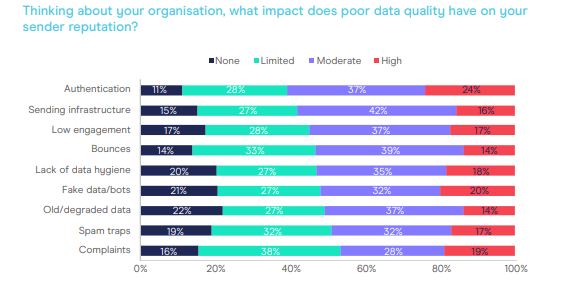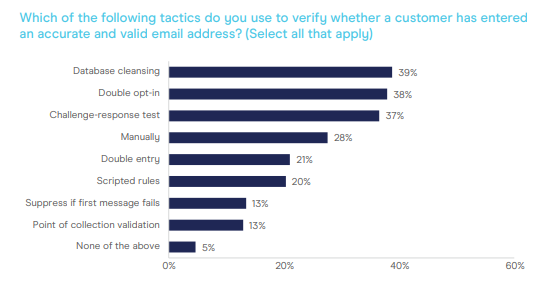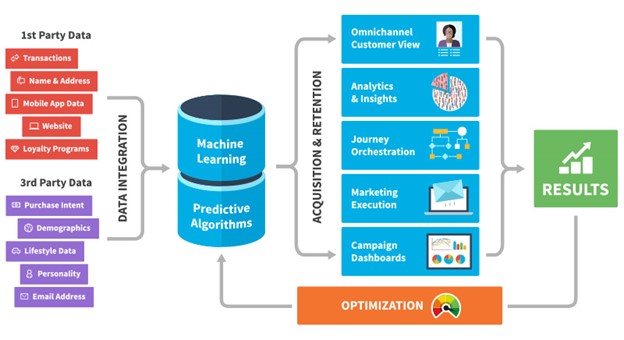Email’s popularity remains undisputed. Nearly everyone uses it – in fact, 92% of online adults use email, with 61% using it on an average day. (source) As a marketing channel, ROI tops the chart with a huge return on investment. For every $1 you spend on email marketing, you can expect an average return of $42.
Take a look at some of these additional statistics on email performance:
- Marketers who use segmented campaigns note as much as a 760% increase in revenue. (Campaign Monitor, 2019)
- 78% of marketers have seen an increase in email engagement over the last 12 months (Not Another State of Marketing, 2020)
- 31% of B2B marketers say email newsletters are the best way to nurture leads. (Content Marketing Institute, 2020)
- 80% of business professionals believe that email marketing increases customer retention. (Emarsys, 2018)
- 59% of respondents say marketing emails influence their purchase decisions. (SaleCycle, 2018)
- 59% of marketers say email is their biggest source of ROI. (Emma, 2018)
- For every $1 spent, email marketing generates $32 in ROI. (Oberlo)
- Conversion rates for emails are higher than social media, direct traffic, and search. (Smart Insights)
- 81% of businesses say that email drives customer acquisition, and 80% for retention. (Emarsys)
- Email offers result in shoppers spending 138% on their purchases. (Disruptive Advertising)

While email has the potential to boost your business success, as with any marketing channel, email is only as successful as the data that drives it. Many marketers put time and resources into optimizing copy, graphics and design, but something as basic as data quality may be overlooked.
Recent research by Validity examined the correlation between email and data quality. To begin, Validity looked at where organizations are storing their customer and email data.

Most respondents stored data in 1 or a combination of three systems:
- CRM – 53%
- Email platform – 50%
- Customer Data Platform – 33%
The good news is that the majority of organizations (77%) are monitoring the quality of their data and many organizations placed importance on data quality.

In comparison to other aspects of email marketing, 9% said data quality is most important, 53% stated its highly important, and 33% stated data quality is moderately important.
Marketers also understand the importance of data quality is relation to how it affects aspects of sender reputation. However, according to Validity’s research, the two factors that experts generally agree are most important for reputation are the two lowest scored (spam traps and complaints) – highlighting the need for some further education on their role and importance.

Organizations have a variety of systems and policies in place to manage data quality with the most popular being compliance (43%).

The most popular metrics organizations use to measure data quality are engagement rates (40%) and sales/revenue (37%).

Email Data Collection
Where are brands sourcing their email lists? The most popular way is through their website (53%), followed by in-person or virtual events (34%), point-of-sale or e-receipts (33%), direct outreach from a sales team (31%), or social media platforms (28%).

The most popular method of verifying data is through database cleansing (39%), using double opt-in (38%), and challenge-response tests (37%).

Data Quality in Email Marketing: Database Append
Brands should be engaging in a regular system of database cleansing to ensure email quality. Email programs are often crippled by both bad data or incomplete customer data, both components of data quality. While a record may have a postal address, a customer’s name or other information, they may be missing recent, reachable email addresses. Email appends are a way to fix these problems.
Email appending is a process that uses data from a known customer record such as a person’s name and postal address. This is then matched to a vendor’s database to add missing emails (or other information) or correct bad emails.
Take a look at the example of an email append program PGM ran for a national retail chain:
Issue: Lacking emails on a portion of their 10 million record CRM database.
Goal: Append as many emails as possible and condition them for email marketing programs. Have the appended emails ready for the Holiday Season.
Solution: PGM performed the append and matched 26.7%. Strategized, developed and executed an email append “warming” program to introduce emails into the inbox and minimize opt-outs. Measure ROI.
Results: After 5 email deployments, the opt out rate was under .5% allowing the majority of emails to be merged into the CRM database and used for the holiday mailings. The PGM appended records outperformed CRM emails by 2.1 times.
Customer Data Platforms to Integrate and Maintain Data Quality
As stated earlier in Validity’s research, more brands are using customer data platforms as a means to store and clean data.
Take a look at some of these statistics on data quality:
- On average 20% of database records contain contact data with data quality issues. (Data Services, Inc.)
- On average, 65% of contact data generated from online web forms is invalid. (Data Services, Inc.)
- 54% of businesses cite data quality and completeness as their largest marketing data management challenge. (Invespcro)
- Approximately 47% of new data collected by businesses has one or more critical errors. (HBR)
- Only 3% of business leaders think their department has an acceptable level of data quality. (HBR)
- Companies with a Data Governance program in place increase data analysis time by 2% and register a 31% improvement in data quality confidence. (Observepoint)
- Businesses with a designated Data Governance or Data Management leader show 42% greater confidence in data quality than those without. (Observepoint)
Customer data platforms can integrate and increase data quality through a series of built-in processes to ensure high-quality data can be accessed at any given time.

Additionally, according to Validity, “the growing number of businesses with a customer data platform (CDP) in place (33%) to store customer data also emerges through the findings as a key indicator of organizations having a more developed approach. These organizations are more likely to have a preference center in place (25%) and use it to collect additional information on their customers (31%) – directly connecting to the pillar of completeness and ensuring brands have all the information they need.”





